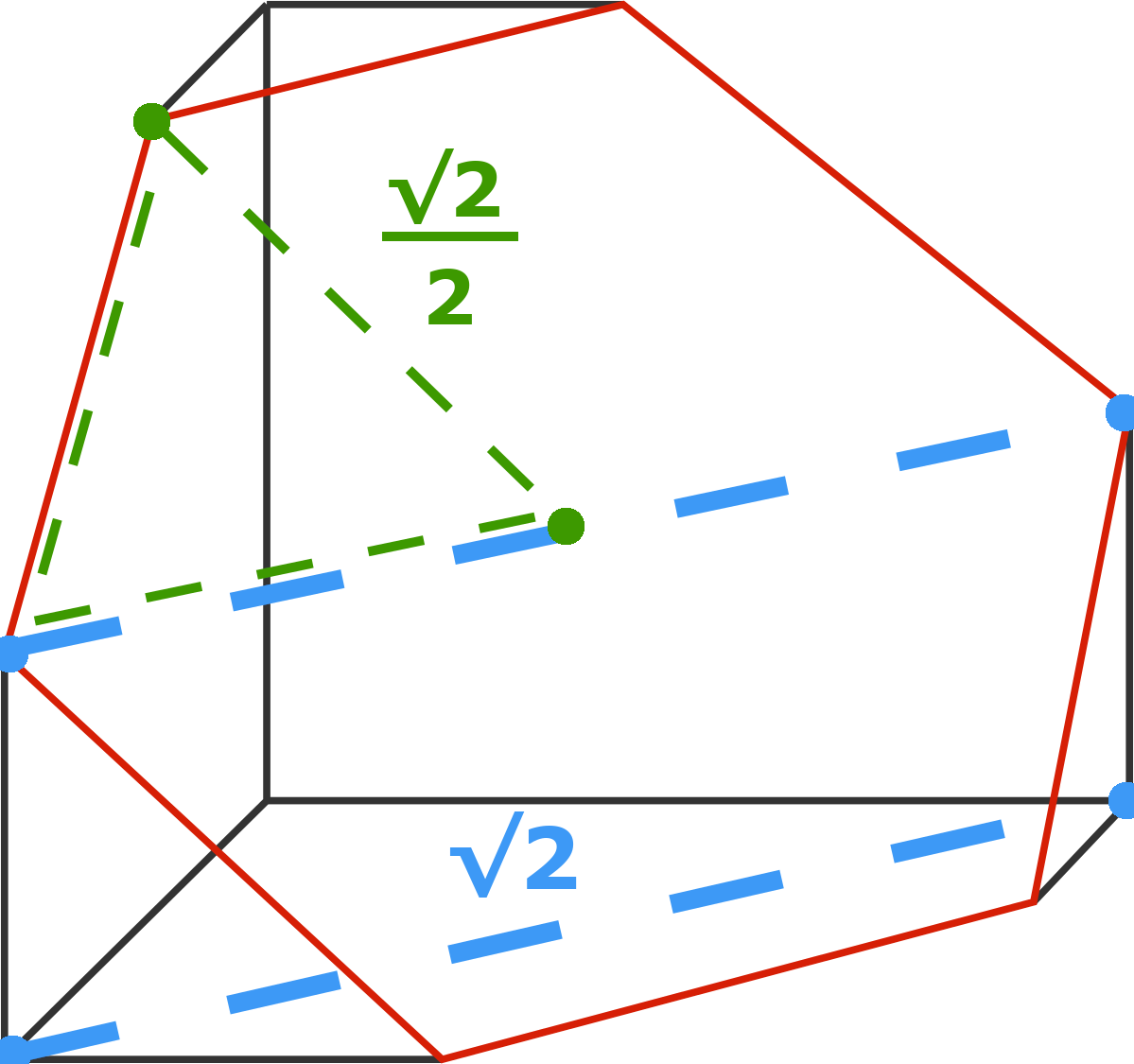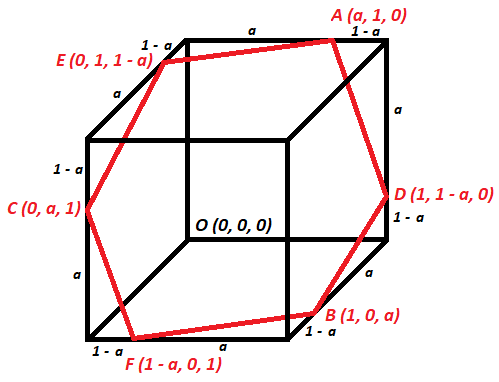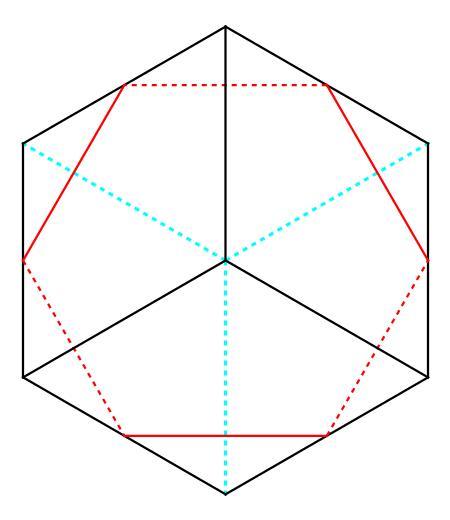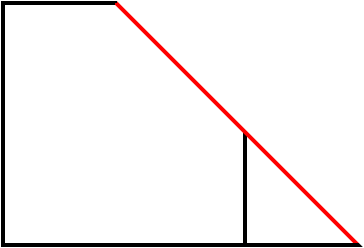Cross section of a cube and a plane
A cube with side length 1 is sliced such that the cut is a regular hexagon (in red).
What is the side length of this regular hexagon (to 4 decimal places)?
The answer is 0.7071.
This section requires Javascript.
You are seeing this because something didn't load right. We suggest you, (a) try
refreshing the page, (b) enabling javascript if it is disabled on your browser and,
finally, (c)
loading the
non-javascript version of this page
. We're sorry about the hassle.
14 solutions
 We see that the diameter of the hexagon is simply the diagonal of the bottom square. Then the side length is simply half of that.
We see that the diameter of the hexagon is simply the diagonal of the bottom square. Then the side length is simply half of that.
I was going to add a solution, but it is not worth it when yours is in the mix. So good!
How do you know that the heights of the endpoints of the diameter are the same? If they are the same, I follow your argument about the diameter = diagonal of the base.
Log in to reply
I was thinking I should've elaborated this better too, but decided that the symmetry of the polygon and its collinear/coplaner bottom points were enough, but I agree that could've been elaborated on better.
What proves that the center of the cube lies on the hexagon, and the diameter of the hexagon is parallel to the base of the cube.
Log in to reply
It is a regular hexagon, therefore its diameter is parallel to its bottom edge which is coplaner to the base of the cube and parallel to the diagonal of the base of the cube. You don't need to prove that the hexagon is in the center of the cube for this problem; once its diameter length is established, the side length is as well.
Log in to reply
Yeah I got your second point about hexagon being in the center but still cannot understand how the regularity of hexagon causes its diameter to be parallel to the base of the cube. Can you please explain? Thanks.
Log in to reply
@Chaitanya Vaishampayan – The hexagon's diameter is parallel to the edges furthest from the diameter, i.e. the one touching the base of the cube; that's a property of regular hexagons. The hexagon's edge is coplaner to the base of the cube; this constrains the diameter to be level with the base of the cube. Finally, the diameter intersects the corner edges of the cube, which further constrains the hexagon's diameter to be parallel to the diagonal of the base of the cube.

abusing symmetry, notice that 2 of the same shapes form the original cube.
it follows that the sides of the right isosceles triangle faces are 0 . 5 , 0 . 5 , 0 . 5 2
∴ 0 . 5 2 = 0 . 7 0 7 1
note: try it yourself, use paint (or any image process software), copy one of them, rotate by 180deg, and overlap them.
yeah thanks sorry i was the late birthday dinner and the a wonderful friend
Let one vertex of the regular hexagon be a away from one vertex of the cube. Since the cube has a side length of 1 , the hexagon vertex must also be 1 − a away from another vertex of the cube. Continuing in this fashion, each vertex of the regular hexagon must be a and 1 − a away from vertices of the cube, as pictured below, so that each side of the hexagon is the same, namely (by Pythagorean's Theorem) s = a 2 + ( 1 − a ) 2 = 2 a 2 − 2 a + 1 .

Now all 6 points of the hexagon must also be in the same plane. Letting one corner of the cube be O ( 0 , 0 , 0 ) , the other vertices can be labeled A ( a , 1 , 0 ) , B ( 1 , 0 , a ) , C ( 0 , a , 1 ) , D ( 1 , 1 − a , 0 ) , E ( 0 , 1 , 1 − a ) , and F ( 1 − a , 0 , 1 ) , as pictured above. Then vector A B = ( 1 − a , − 1 , a ) , vector A C = ( − a , a − 1 , 1 ) , vector A D = ( 1 − a , − a , 0 ) , A B × A C = ( − a 2 + a − 1 , − a 2 + a − 1 , − a 2 + a − 1 ) , and A D ⋅ ( A B × A C ) = 2 a 3 − 3 a 2 + 3 a − 1 . In order for A , B , C , and D to be coplanar, A D ⋅ ( A B × A C ) must equal 0 , and solving 2 a 3 − 3 a 2 + 3 a − 1 = 0 gives a = 2 1 . (For completeness, we can also show that E and F also lie on the plane when a = 2 1 because the equation of the plane is x + y + z = 2 3 )
Therefore, side length of the regular hexagon is s = 2 a 2 − 2 a + 1 = 2 ( 2 1 ) 2 − 2 ( 2 1 ) + 1 = 2 2 ≈ 0 . 7 0 7 1 .
Definitely a good solution!!!
I approached it this way too...except I decided to find the lengths of 2 of the sides using the "root of the sum of squares" of the vectors describing the side.
Is it possible for the hexagon to be regular if a!=0.5 ?
Log in to reply
I mean, this is a slice of a cube.
if a = 0 . 5 i think the points (A, B, C, D, E, F) will not be in the same plane anymore...
what i'm curious is what happens if not all points in the cut are splitting the edges in the same ratio. Meaning A splits its edge into a : 1-a, B splits its edge into b : 1-b, etc...
Log in to reply
If not all the points in the cut split the edges in the same ratio, then the hexagon would not be regular, because it would have sides a 2 + ( 1 − e ) 2 , d 2 + ( 1 − a ) 2 , b 2 + ( 1 − d ) 2 , f 2 + ( 1 − b ) 2 , c 2 + ( 1 − f ) 2 , and e 2 + ( 1 − c ) 2 .
For a regular hexagon from a cube, the cut must be made through the midpoints of the edges and at angle of 45°. As the side of the hexagon ( say S ) is the hypotenuse of the isosceles triangle, by Pythagoras theorem
S = 2 ( 0 . 5 ) = 0 . 7 0 7 1
Any justification for that 1st statement? Because it's clear that if the cut is made through the midpoints and at 45° then the cut is a regular hexagon, but why must it be like this? Why is this the only way to cut a cube into a regular hexagon?
Here's a view down the long diagonal of the cube.

Due to the symmetry of the shape, we know that each corner of the hexagon has the same set of angles with respect to the cube.
As the hexagon edges draw lines on the cube between pairs of perpendicular lines, the only way the angles can be the same is if the angle is 4 5 ∘ .
This means we can fold two adjacent faces out like this:
 Since the angle is
4
5
∘
, the diagonal line has the same length as a line between two opposite corners on a full unit square face. This means its length is
2
.
Since the angle is
4
5
∘
, the diagonal line has the same length as a line between two opposite corners on a full unit square face. This means its length is
2
.
As both halves of the red line are sides of a regular hexagon, they are the same length. This means each hexagon side is 2 2 ≈ 0 . 7 0 7 1 .
After you slice it, you have two parts of the cube and both of them have the same hexagon . So the two parts of the cube are alike (this is the claim that I am not entirely sure)
Since they are equals, the sides were cut in half , so the sides of same length of the isosceles triangles are 0.5
The hypotenuses (which are the sides of the hexagon) are 2 1
The upper edge in the back is cut into two parts: a remains at the top left and b was cut away. Recall that a + b = 1 . Since the hexagon is regular it holds that an edge of it has the length c = a 2 + a 2 = b 2 + b 2 . Hence, a = b = 2 1 and c = 2 1 .
Each face intersected by the cut has a right isosceles triangle removed. By symmetry of both the cube and hexagon, all of these triangles are congruent. When when two such sides share an edge, the short legs of the right isosceles triangle bisect the edge. This means the short legs of these triangles have length 0.5. The hypotenuses of these triangles, which are also the sides of the hexagon, have length sqrt(0.5^2+0.5^2)=sqrt(2)/2=0.7071....
This section of cube has 7 faces:
-
3 isosceles right triangles (congruent)
-
3 congruent trapezia
-
1 regular hexagon
Let r = side length of hexagon. Then non hypotenuse sides of triangles are r/√2 each. Now imagine the missing triangular part for each trapezial face. By symmetry, missing triangle ≈ triangular face and consequently we get
(1-(r/√2)) = r/√2
Which gives r ≈ 0.7071.
For all the sides of the hexagon to be equal the corners must be at the centres of the edges of the cube. So the length of the sides is √((1/2)squared + (1/2)squared) = √((1/4) + (1/4)) = √(1/2) =1/√2 = 0.7071.
Here is a simple solution. Analogy: it is a regular hexagon; For all sides of the hexagon to be equal, it should pass through the diagonal of the cube(not the centre diagonal(longest), but the face diagonal). A regular hexagon is made up of six equilateral triangles and all diagonals are equal. So, half of the diagonal should be a side of an equilateral triangle.
Math: Side of cube=1; face diagonal of the cube is 2 . So, the side of the regular hexagon is 2 2 ~ 0.7071.
I got the analogy, by looking at my Rubiks cube for a while and imagining cutting it in different angles as shown in the figure.
Side of hexagon=√{(a/2)^2+(a/2)^2}, where 'a' is side of the cube.
